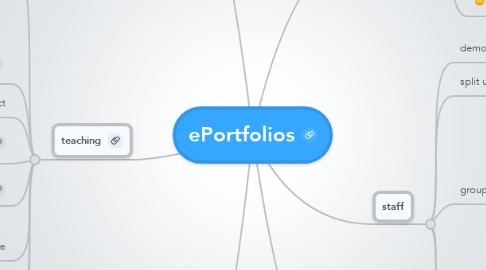
1. teaching
1.1. ePortfolio.org
1.2. Mahara.com
1.3. Open Source Portfolio - Sakai Project
1.3.1. Developed with 6 priorities
1.3.1.1. Usability and Customization
1.3.1.2. Assessment and Accreditation
1.3.1.3. Integration Interfaces
1.3.1.4. Scholarship of teaching and learning
1.3.1.5. Templates
1.3.1.6. Portability
1.4. General information found online. Shows examples
1.5. eFolio - Minnesota
1.5.1. available to all residents, intended for students and teachers, implemented state wide
1.6. Chalk & Wire
1.6.1. UNISA example
1.6.1.1. implimented an innovated evaluation system, without GPAs
1.6.1.1.1. C&W supported eportfolios as outcome measures
1.6.1.2. constructivist approach, very innovative
1.6.2. almost LMS in nature
1.6.2.1. portfolio creation
1.6.2.2. assessment and feedback built in
1.6.2.2.1. has tools for flexible criteria
1.6.2.3. surveys and forms
1.6.2.4. reporting and analytics
1.6.2.5. collaborative tools
1.6.2.5.1. self-contained, not interoperable
1.6.2.6. administrative flexibility
1.7. Digication
1.8. WordPress
1.8.1. technically a blogging tool
1.8.1.1. free opensource
1.8.1.1.1. student as designer
1.8.1.1.2. formative assessment in terms of peer feedback, or tags
1.8.1.1.3. summative in nature if teacher scaffolded task - depends on user objective or learning objective
1.8.1.1.4. useful for collecting and reflecting and
1.8.1.2. cognitive tool in terms of organization
1.8.1.2.1. high cognitive load
2. Expectise
2.1. State Learning Outcomes
2.2. Overview
2.3. Give Overview on articles
2.3.1. eFolio Minnesota
2.3.1.1. 6 points!
2.4. Break into groups
2.4.1. discussion questions for eFolio Minnesota
3. staff
3.1. demo examples of EPs
3.2. split up presentation between us
3.3. group activities
3.3.1. critical evaluation
3.3.1.1. based on critical criteria
3.3.1.2. also, based on past research
3.3.1.3. have students come up with criteria?
3.3.2. process/product debate
3.3.3. reflect on personal experience with EPs using WordPress.com
3.4. take away tools
3.4.1. ex, how to build your own
3.5. visual presentation
3.5.1. screen captures
3.5.2. video
4. Student
4.1. 5 Processes of the Portfolio
4.1.1. Collecting
4.1.2. Selecting
4.1.3. Reflecting
4.1.4. Directing/Goals
4.1.5. Presenting
4.2. eportofolios as a cognitive tool
4.2.1. organizing and structuring enhances comprehension
4.3. Challenges of eportfolios
4.4. examples of eprotfolios
4.5. eportfolios and evaluation
5. learning
5.1. UNISA
5.1.1. Introduction
5.1.1.1. "governments and higher education must cultivate a learning society"
5.1.1.2. life-long learning
5.1.1.3. life-wide learning
5.1.2. research
5.1.2.1. goal: to see how users are using it
5.1.2.2. 6 functions of ePortfolios
5.1.2.2.1. educational planning
5.1.2.2.2. document knowledge, skills, abilities
5.1.2.2.3. tracking development
5.1.2.2.4. finding a job
5.1.2.2.5. evaluation with a course
5.1.2.2.6. performance monitoring
5.1.2.3. disproportionately used by people with advanced education
5.1.2.4. Role shifting
5.1.2.4.1. people's use of it changed over time
5.1.2.4.2. Role shifting suggests that eFolio is doing what it is designed to do for many of its active users, promoting lifewide and lifelong learning
5.1.2.5. Experimentation and the Living Document
5.1.2.5.1. 3 phases
5.1.2.6. Impact through...
5.1.2.6.1. Audience
5.1.2.6.2. Integrity
5.1.2.7. institutions can support ePortfolios by
5.1.2.7.1. encouraging collaboration
5.1.2.7.2. initial introduction and support
5.1.3. implications for practice
5.1.3.1. support access
5.1.3.1.1. free access
5.1.3.1.2. local support at school levels
5.1.3.1.3. reach communities outside education
5.1.3.2. foreground planning
5.1.3.2.1. materials supporting planning
5.1.3.2.2. include prompts and scaffolds to encourage it
5.1.3.2.3. organizations support its use
5.1.3.3. promote findability
5.1.3.3.1. control over who sees what
5.1.3.3.2. providing standardized formats supporting search
5.1.3.3.3. integration with job search databases
5.1.3.4. cultivate audiences
5.1.3.4.1. guidance and support to potential viewers
5.1.3.5. capture activity
5.1.3.5.1. feedback to users on how it's accessed
5.1.3.6. enable layering
5.1.3.6.1. same content to be navigated differently by different users for different purposes
5.1.3.7. foreground the personal
5.1.3.7.1. opportunities for identity expression
5.1.3.8. cultivate collaborative contexts
5.1.3.8.1. interaction reported as being important
5.1.3.9. promote integral introductions
5.1.3.9.1. users benefited from seeing the range of possible ways of expression
5.1.4. produce-oriented process
5.1.4.1. contributes to comprehending the tension
5.1.5. Mahara
5.1.5.1. an ePortfolio platform
5.1.5.2. available to all state residents
5.1.5.3. designed intentionally for life-long and life-wide learning
5.1.5.4. flexible templates for workers, students, & educators
5.1.5.5. dominated by students, still many worker and educator profiles
5.2. further research
5.2.1. fuller account of role shifting
5.2.2. how readers make sense of eFolios
5.2.3. inventory of effective practices for broader implimentation
5.2.4. promotion of use in other states/countries
6. school Management
6.1. Compare treaditional portfolios to EP in relation to the learning
6.2. Is the qualitative vs quantitative paradigm appropriate to fully understand the impact of EP? Abrami and Barrett, 2005
6.3. What are the challenges of EP's with respect to assessment?
6.4. Are e Portfolios valuable forms of assessment?
6.4.1. If so, how are they used to facilitate integrative learning experiences? (Peet et al., 2011)
6.4.2. Do ePorts provide an environment for integrative learning (Peet et al...)
6.4.3. Assessor must use clear assessment framework that clearly articulates competencies and expected learning outcomes (Barrett article, my page 3) And, Abrami/ Barrett ask what is evidence of EP success?

